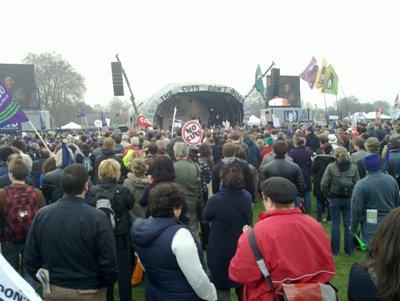|
|
London Unites to Save Jobs and Services
un article par Jo Lofgren
On Saturday 26 March 2011, more than 250,000 people converged on the north riverbank in central
London to march through the city towards Hyde Park to oppose the British Government's policy of
stringent cuts to services and jobs. The march was organised by the trade unions and a number of
civil society organisations and brought together teachers, firefighters, social workers, civil
servants, families, young people and pensioners. 
A scene from the London demo
click on photo to enlarge
A multiplicity of views and arguments were heard
for how the situation could be addressed without cutting vital frontline services, including
proposals to scrap the Trident missile programme and to adopt a staggered approach to reducing
government spending instead of the current shock therapy.
Many people found themselves marching on
Saturday because they felt that other options for expressing their opinion had not been heard. There
has been a media storm in the United Kingdom in recent months connected to major healthcare,
education and social care reforms.
The country is deep in debt and the government is cutting far and deep across almost all aspects of services in an attempt to reduce that deficit.
An interesting
thing to note is that very few people disagree that spending has to be reduced. However, opinions
diverge along political lines as to how this should be done.
Yesterday's demonstration was a popular
expression of the very strong belief held in this country about the welfare state and about the
government's role in looking after its own people - making sure that everyone can live a life with
dignity, that nobody goes hungry, and that everyone has access to excellent health care, education
and the help they need when they get old.
At this stage in human development in one of the most
'developed' countries in the world, is that such a strange thing to be marching for, to believe in?
|








|
DISCUSSION
Question(s) liée(s) à cet article:
How effective are mass protest marches?,
* * * * *
Commentaire le plus récent:
Hi.
I have two comments about this report. The first is on the question about the effectiveness of mass protest marches.
Recalling the effectiveness of mass protest marches in the 1978 Iranian Revolution, I looked it up on a search engine and found the following account of the revolution's climax"
"In November, the Shah turned the government into a military government in order to force strikers back to work. But the worst, everyone knew, was about to come. The month of Muhurram was approaching, the month in which Shi'ites traditionally celebrate the martyrdom of Husayn. It is a passionate and highly religious month, and since the protests against the Shah were largely religious in nature, everyone knew that the country was on the verge of exploding.
Muhurram began on December 2 with demonstrations, and these demonstrations would continue all throughout the month. They were massive, in the millions, and it was clear that the demonstrators, not the government, was in charge. . ... continuation.

|
|









